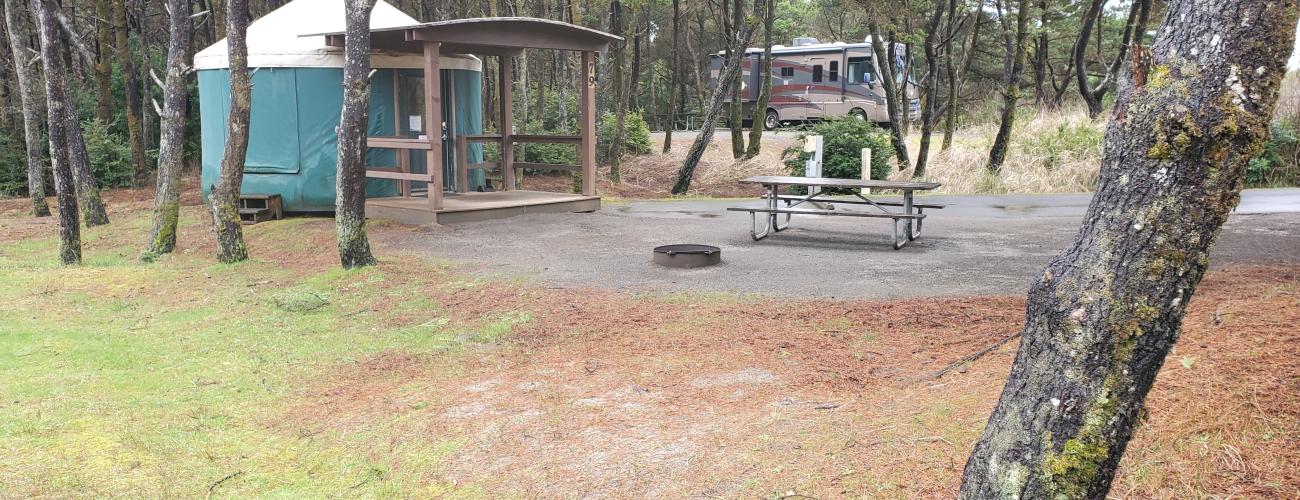Grayland Beach State Park History
The Coast—Accretion and Erosion
Massive volumes of sand and sediment are carried to the coast from deep in the interior of the state by the Chehalis River, Columbia River, and other rivers and streams. Once these sediments have emptied into the Pacific Ocean they are moved by waves and coastal currents. In winter months, sediments generally migrate parallel to the coastline. In summer months the sediments are pushed toward the shoreline. Once the sand has been added to the beach, winds blow the sand grains farther. Predominant winds from the southwest and southeast mold linear dunes parallel to the coastline. Once plants have stabilized the deep and well-drained fine sand of the dunes, the linear depressions between dunes collect deep and poorly drained loamy sand that frequently flood in the wet winter months.
Modifications to the natural ebb and flow of sand on the coast have come from dams that trap sediment on the Columbia River, dredging of navigation channels at the mouth of the Columbia River and the entrance to Grays Harbor, and the construction of jetties.
Indigenous Lands
The park lies within the traditional territories of Coast Salish Indigenous people whose present-day descendants include members of the Shoalwater Bay Indian Tribe and Confederated Tribes of the Chehalis Reservation. For thousands of years this area has provided habitat for a diverse community of life that forms the basis of their cultures.
Local tribes refused to accept the conditions proposed by Washington Territorial Governor Isaac Stevens at the Chehalis River Treaty Council in February 1855. Subsequently, title to the land was relinquished to the US federal government and the Chehalis Reservation was established by executive order of Secretary of the Interior J. P. Usher on July 8, 1864. On September 22, 1866, President Andrew Johnson established the Shoalwater Bay Reservation by executive order.
Government surveys were completed in 1858 and land in today’s park passed into private ownership with Cash Entry Patents, a form of land sales from the public domain, issued between 1873 and 1891.
Camping by the Pacific Surf
The Washington State Parks and Recreation Commission (WSPRC) realized the demand and need for additional public recreation areas on the Pacific Ocean and purchased the first parcel of land for Grayland Beach State Park in 1959 from Daisy Benn, who had also provided one of the initial parcels making up nearby Twin Harbors State Park. A campground with 60 sites opened in 1974. The park was officially dedicated on February 23, 1975.
The popularity of Grayland Beach State Park encouraged the WSPRC to authorize a $2.2 million renovation and expansion of the campground in 2004. 52 additional sites with water and electric hookups were added, with easy access through the dunes to the ocean beach. The project also included a new visitor welcome center, additional standard campsites, primitive sites for visitors arriving on bicycle or by foot, and yurts scattered throughout the campground.
Razor Clams
Many visitors come to Grayland Beach to harvest razor clams. The Pacific Razor Clam (Siliqua patula) is an exceptionally meaty shellfish that inhabits a niche between the +3-foot tide level and the -2-foot tide level.
In 1984, populations of razor clams at Grayland Beach and elsewhere along Washington’s coast plummeted more than 95% due to infection by a bacterial pathogen known as nuclear inclusion X (NIX). Since then, seasons have been variable and closely linked to monitoring of populations, adult mortality and presence of marine toxins concentrated in the clams.
Clam diggers with proper licensing can take advantage of announced season openings at Grayland Beach State Park. Clams are best collected in the hours before a low tide, when receding water leaves behind soft sand where quarter-sized dimples in the sand give away the clams’ location. Razor clams can dig downward into the sand quite rapidly, requiring equally rapid digging to pursue them.
Sharing the histories of Washington’s state parks is an ongoing project. Learn more here.

